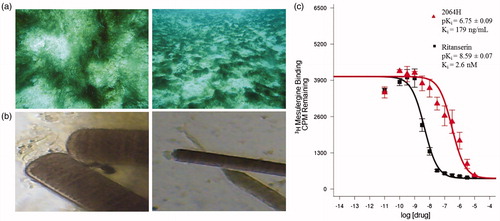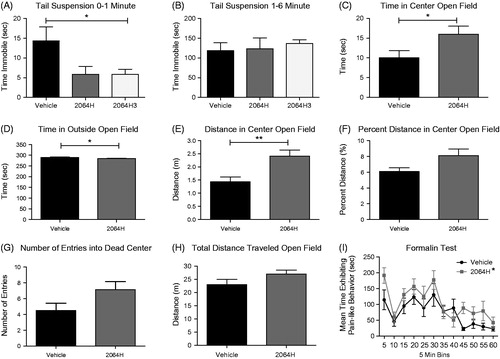Figures & data
Figure 1. Picture of cyanobacteria 2064 and apparent Ki curve for fraction 2064H (A) Photo of the cyanobacterium in the field; (B) microscope image of the cyanobacterium shown at 40 × (left) and 10 × magnification; (C) Apparent Ki curve for fraction 2064H showing the standard 5-HT2c ligand ritanserin for comparison.

Table 1. Selected bioassay results of 2064H.
Table 2. Apparent Ki for PDSP hits.
Figure 2. HPLC chromatogram of 2064H. Reverse Phase HPLC (100 μL injection; 10 mg/mL); Major peak at 16.440 min and 2573 mAU was isolated as pure compound 2064H3.

Figure 3. Behavioral effects of fraction 2064H and pure compound 2064H3 in vivo (A) Mice treated with 2064H3 (n = 6) significantly decrease time immobile compared to vehicle (n = 6) in the first min of the tail suspension test; mice treated with 2064H (n = 6) show a similar trend. (B) These same animals show no difference in immobility time in the latter half of the test. (C) Mice treated with 2064H (n = 8) spend more time in the center of the open field box compared to vehicle treated mice (n = 8). (D) 2064H-treated mice also show a decrease in the time spent in the outside of the open field apparatus. (E) Mice treated with 2064H travel more in the center of the open field box compared to vehicle. (F) Mice treated with 2064H show a trend of having a greater percent distance traveled in the center of the open field box compared to vehicle (p = 0.051). (G) 2064H-treated mice also show a trend in entering the dead center of the open field box more than vehicle-treated mice (p = 0.075). (H) 2064H-treated mice showed no difference in total distance traveled compared to vehicle-treated mice. (I) Mice treated with 2064H (n = 8) show an overall main effect of treatment (2-way ANOVA) of increasing pain-like behaviors compared to vehicle-treated mice (n = 8) in the formalin test. A,C,D,F – *p < 0.05, **p < 0.01, unpaired t-test; I – *p < 0.01, 2-Way ANOVA main effect of treatment. Data shown as mean ± SEM.

